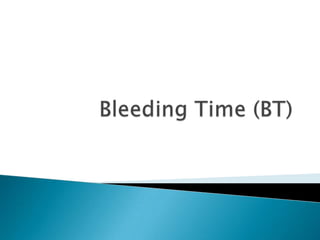
mbbs ims msu
- 2. The bleeding time test is used to evaluate how well a person's blood is clotting. The test evaluates how long it takes the vessels cut to constrict and how long it takes for platelets in the blood to seal off the hole. Blood vessel defects, platelet function defects, along with many other conditions can result in prolonged bleeding time. Definition
- 3. Two techniques Duke’s method : Earlobe (Obsolete) Ivy’s method : Forearm (Today use)
- 4. An incision 5 mm long x 1 mm deep is made on the lateral aspect of the surface of the forearm and the time to cessation of bleeding is measured. Constant pressure (supplied by a sphygmomanometer) of 40 mm Hg. is applied and a disposable incision device is used to standardize the procedure. Provided that fibrinogen levels and platelet count is normal, this procedure will detect defective platelet function and is used as a screening test for inherited and acquired platelet defects. Ivy’s method Principle
- 5. Incision vs Puncture Incision Puncture
- 6. Specimen The test is performed on forearms only Small children may have to be restrained as excessive movement may render performance difficult and may invalidate the test. The patient should be advised as to the possibility of some scaring. An accurate drug history is often useful to the interpretation of the test. The test may be performed routinely if the platelet count is in excess of 100,000/mm3 and a free arm is available.
- 7. Equipment stopwatch sphygmomanometer (blood pressure cuff) filter paper (Whatman No 1) Surgicutt tm Automated Incision Making Instrument or lancet or Blade 70% alcohol prep butterfly bandages Surgicutt Blade Lancet
- 8. Calibration and Control Calibration: None Quality Control: No external QC is available. Care must be taken to standardize the procedure. The protocol must followed exactly!
- 9. Select a site on the patient's arm on the lateral aspect surface that is free of veins, bruises, edematous areas, and scars and is approximately 5 cm below the antecubital crease. Clean the site with the alcohol prep. Place the sphygmomanometer around the patient's arm approximately two inches above the elbow and maintain 40 mm Hg. Make the incision by pushing the lancet into the skin (1/2 the length), then remove the device. Discard the device in a "sharps" container. Procedure
- 10. Start the timing device and blot the edge of the incision at 30-second intervals with the filter paper. Do not touch the incision with the filter paper. Note the time that bleeding stops and report to the nearest 30 seconds. Note: If the bleeding time exceeds 15 minutes: stop the procedure apply pressure to stop the bleeding To minimize scaring, bandage with a bandage is applied perpendicular to the incision. 10 Procedure
- 12. Note Expected results:Normal Values: 2- 9 minutes. In general not exceed 6 minutes.
- 13. Errors producing false positive results Blood pressure cuff maintained too high (>40mm Hg.) Incision too deep, caused by excessive pressure on the incision device. Disturbing the clot with the filter paper. Low fibrinogen (<100 mg/dl) or platelet count (100,00 /mm3). Drug ingestion affecting platelet function (e.g. asprin) Errors producing false negative results Blood pressure cuff maintained too low (<40 mm Hg). Incision too shallow. Sources of error
- 14. The bleeding time test is primarily a test of platelet function. It is usually significantly prolonged in the case of congenital or acquired platelet defects. Disease states in which abnormal bleeding times may be found include: Von Willebrand's Disease Sensitivity to Asprin Clinical significance
- 15. Function of Platelets Stop bleeding from a damaged vessel * Hemostasis Three Steps involved in Hemostasis 1. Vascular Spasm 2. Formation of a platelet plug 3. Blood coagulation (clotting)
- 17. Vessel walls pressed together – become “sticky”/adherent to each other
- 19. (+) Feedback promotes formation of platelet Plug
- 20. Thrombin Final Step in Hemostasis Blood Coagulation (clot formation): Transformation of blood from liquid to solid Clot reinforces the plug Multiple cascade steps in clot formation Fibrinogen (plasma protein)Fibrin
- 21. Factor X Thrombin in Hemostasis
- 22. Clotting Cascade Participation of 12 different clotting factors (plasma glycoproteins) Factors are designated by a roman numeral Cascade of proteolytic reactions Intrinsic pathway / Extrinsic pathway Common Pathway leading to the formation of a fibrin clot !
- 23. X Hageman factor (XII) inactive active CLOT !
- 24. Clotting Cascade Intrinsic Pathway: Stops bleeding within (internal) a cut vessel Foreign Substance (ie: in contact with test tube) Factor XII (Hageman Factor) Extrinsic pathway: Clots blood that has escaped into tissues Requires tissue factors external to blood Factor III (Tissue Thromboplastin)
- 25. Clotting Cascade Fibrin : Threadlike molecule-forms the meshwork of the clot Entraps cellular elements of the blood forms CLOT Contraction of platelets pulls the damaged vessel close together: Fluid squeezes out as the clot contracts (Serum)
- 26. Clot dissolution Clot is slowly dissolved by the “fibrin splitting” enzyme called Plasmin Plasminogenis the inactive pre-cursor that is activated by Factor XII (Hageman Factor) (simultaneous to clot formation) Plasmin gets trapped in clot and slowly dissolves it by breaking down the fibrin meshwork
- 27. Clot formation:Too much or too little of a good thing… Too much: Inappropriate clot formation is a thrombus (free-floating clots are emboli) An enlarging thrombus narrows and can occlude vessels Too little: Hemophilia- too little clotting- can lead to life-threatening hemorrhage (caused from lack of one of the clotting factors) Thrombocyte deficiency (low platelets) can also lead to diffuse hemorrhages
